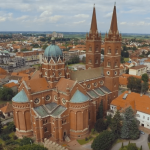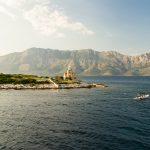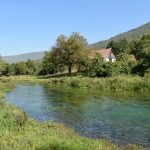March 1, 2020 – Split photographer EdoStuff Aviation captures the Glavas fort ruin.
Dalmacija Danas writes that the Glavas fort is a ruin in the medieval and the early modern town of Glavas in Croatia.
The fort was built on a rock that dominates Pekas on the slope of Dinara, which descends towards the valley around the source of the Cetina River.
In addition to the defensive walls, some parts of the fort are also defended by inaccessible terrain, especially from the west, where the terrain plunges into a gorge. Today, the fortress is approached from the village of Glavas, some three hundred meters away. You can access it by a hiking trail from which you can take to climb to the top of Dinara.
Glavas fort got its present name only in the 17th century, as expected in the village of Glavas in the Municipality of Kijevo. From the north, it protected the area of the source of the Cetina River and the access through the highest peaks of Dinara and Unista from the direction of Livno and Glamoc fields in Bosnia and Herzegovina.
The route has been used since prehistoric times for the needs of local livestock and mountain grazing, but it is not yet clear whether any essential Roman roads went along this route into the area of the Livno Field. The location of the fort suggests that this is the point from which it is easiest to control a possible enemy penetrating behind Dinara in present-day Bosnia and Herzegovina. In prehistoric times, at the site of the fort, there was a hill fort to control this important point, which was confirmed by small findings during research.
Historical information about the Glavas fort reveals, first of all, its former name: on the famous map of Matea Pagana from the first half of the 16th century, it is called Dinaric. Even then, the Ottomans held it. The Glavas fort (Dinaric) at the end of the Middle Ages (in the 14th or 15th century) was owned by the Croatian noble clans of Čubranović, Mišljenović and Berislavić and there is no historical or archaeological evidence that it was built before that time. Medieval pottery and metal can be dated only from the 15th century. The Ottomans conquered the Glavas fort, apparently at the beginning of the 16th century, and held it continuously until the beginning of the 18th century, when it was abandoned and its decline began.
Check out the video of the Glavas Fort from Split photographer EdoStuff Aviation below.
https://www.youtube.com/watch?v=v=1gYkWon7mkE
To read more about lifestyle in Croatia, follow TCN’s dedicated page.









